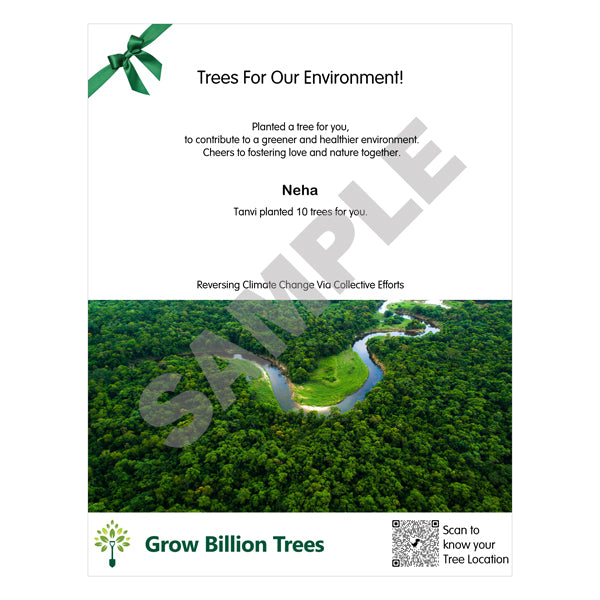


Description: Planting trees is a crucial strategy for addressing environmental concerns, combating climate change by absorbing carbon dioxide and rele Read more
Description:
Planting trees is a crucial strategy for addressing environmental concerns, combating climate change by absorbing carbon dioxide and releasing oxygen. Trees for the environment play a pivotal role in environmental conservation.
A single mature tree can absorb a remarkable 22 KGs (48 pounds) of CO2 annually, providing a habitat for wildlife and contributing to energy conservation through shade in the summer and windbreaks in the winter.
Scope:
- Enhancement of Biodiversity
- Increase in Green Cover
- Reduction of Man-Animal Conflict
- Generation of Rural Employment
- Improvement of Wildlife Habitats
Tree Species:
The species of trees that are planted depend on the project, and they are chosen based on their native habitat in the corresponding ecological zone.
Why trees?
Beyond World Environment Day, planting trees becomes a celebration of the planet, expressing gratitude for its myriad gifts. Here are compelling reasons to plant trees for the environment:
- Trees, akin to environmental superheroes, absorb carbon dioxide, release oxygen, provide wildlife habitats, and combat soil erosion – all while adding aesthetic appeal.
- Consider this: one mature tree can absorb up to 22 KG (48 pounds) of carbon dioxide annually, marking a substantial environmental impact.
- Trees contribute to energy efficiency, offering shade in summer and acting as windbreaks in winter, thereby lowering heating and cooling costs.
- Tree planting fosters community unity, presenting an opportunity to organize tree-planting events that engage friends, family, and neighbors in a collective and enjoyable activity.
- Lastly, planting trees is a profound gesture of environmental stewardship, reflecting care for the planet and providing a wonderful reason to connect with nature.
Emphasizing these five compelling and engaging reasons encourages tree planting for the environment. Every planted tree contributes to safeguarding the planet, making each effort significant.
Social Impact:
Planting trees can have several social and community benefits, helping reduce carbon emissions and combat climate change. Some of how tree planting can positively impact the community include:
-
Encouraging community involvement: Planting trees as a community activity can bring people together and promote social connections.
-
Fostering a sense of belonging: Participating in a tree-planting event can help to build a sense of ownership and pride in the community.
-
Promoting education and awareness: Tree planting can provide an opportunity for education and learning about the environment, raising awareness about the importance of trees and the role they play in the health and well-being of the planet.
-
Inspiring positive change: By planting trees and sharing the experience with others, you can inspire others to take action and positively impact the environment. This can have a ripple effect, promoting sustainability and positive change in the community and beyond.
Overall, tree planting can be a meaningful and impactful way to contribute to the health and well-being of the community and the environment.
Carbon Sequestration by Trees
Trees play a crucial role in carbon sequestration, absorbing carbon dioxide from the atmosphere and storing it in their biomass, thereby mitigating the effects of climate change.
Wildlife Habitat Creation
Trees provide essential habitats for a diverse range of wildlife species, supporting biodiversity conservation and ecosystem health.
Erosion Control with Trees
Planting trees helps prevent soil erosion by stabilizing slopes, reducing runoff, and enhancing soil structure, thereby protecting valuable land resources.
Community Tree Planting Events
Organizing community tree planting events fosters social cohesion, promotes environmental awareness, and encourages collective action for a greener future.
Urban Greening Initiatives
Implementing urban greening initiatives through tree planting enhances the quality of urban environments, improves air and water quality, and enhances the overall well-being of city residents.
Agroforestry Practices
Incorporating trees into agricultural landscapes through agroforestry practices improves soil fertility, increases crop yields, and provides additional income opportunities for farmers.
Tree-Based Livelihoods
Trees contribute to rural livelihoods by providing timber, fruits, nuts, and other forest products, thereby generating income and employment opportunities for local communities.
Climate Resilience with Trees
Trees contribute to climate resilience by moderating temperature extremes, reducing the risk of natural disasters, and providing crucial ecosystem services to vulnerable communities.
Tree Diversity and Adaptation
Planting a diverse range of tree species enhances ecosystem resilience and adaptation to changing environmental conditions, ensuring long-term sustainability.
Educational Tree Planting Programs
Implementing educational tree planting programs in schools and communities promotes environmental literacy, instills a sense of environmental stewardship, and empowers individuals to take action for the environment.
FAQ
How do trees contribute to environmental conservation?
Trees play a crucial role in environmental conservation by absorbing carbon dioxide, providing wildlife habitats, preventing soil erosion, and enhancing biodiversity.
What is carbon sequestration, and why is it important?
Carbon sequestration refers to the process of capturing and storing carbon dioxide from the atmosphere. Trees sequester carbon through photosynthesis, helping mitigate climate change by reducing greenhouse gas emissions.
How do trees support wildlife habitats?
Trees provide essential habitats for a diverse range of wildlife species, offering food, shelter, and nesting sites, thus supporting biodiversity conservation and ecosystem health.
How can community tree planting events benefit society?
Community tree planting events promote social cohesion, raise environmental awareness, and encourage collective action for a greener and more sustainable future.
What are the environmental benefits of urban greening initiatives?
Urban greening initiatives, such as tree planting, improve air and water quality, reduce urban heat island effects, and enhance the overall well-being of city residents.
What is agroforestry, and how does it benefit agriculture?
Agroforestry integrates trees into agricultural landscapes, improving soil fertility, increasing crop yields, and providing additional income opportunities for farmers.
How do trees contribute to rural livelihoods?
Trees provide timber, fruits, nuts, and other forest products, generating income and employment opportunities for local communities, especially in rural areas.
In what ways do trees enhance climate resilience?
Trees moderate temperature extremes, reduce the risk of natural disasters, and provide crucial ecosystem services to vulnerable communities, contributing to climate resilience.
Why is tree diversity important for ecosystem sustainability?
Planting a diverse range of tree species enhances ecosystem resilience and adaptation to changing environmental conditions, ensuring long-term sustainability and biodiversity conservation.
How can educational tree planting programs benefit communities?
Educational tree planting programs promote environmental literacy, instill a sense of environmental stewardship, and empower individuals to take action for the environment, fostering a culture of sustainability.



